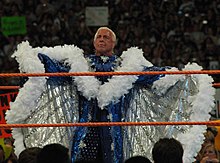Gimmick (wrestling)
In wrestling, gimmick describes the character of a wrestler shown in the ring. The term is derived from the English advertising language, in which Gimmick describes the special and unique features of a product.
function
Like advertising gimmicks , the gimmick in wrestling serves business. Their gimmicks make wrestlers more interesting and attract more audiences. A working gimmick promotes the popularity of a face or the unpopularity of a heel with the audience. A successful gimmick can accompany a wrestler throughout his career. Gimmicks that don't get the desired reactions are usually dropped, so a wrestler may have impersonated several gimmicks over the course of his career. Wrestling gimmicks offer starting points for storylines and are subject to their developments, so that a wrestling gimmick can change in the course of its use. For example, “Doink the Clown” was a clown with characteristics that were reminiscent of Stephen King's Es . After the figure was changed to the face, the gimmick was a typical, funny circus clown . Particularly successful gimmicks are often adopted by other wrestlers, examples of which are the “Nature Boy” gimmick, which was first used by Buddy Rogers and later by Ric Flair , or the “Wild Samoan” gimmick by the headshrinkers . Occasionally gimmicks are copied by competing operators, as appeared in the World Wrestling Federation shortly after the first successes of the Road Warriors in Georgia Championship Wrestling with Demolition and Mid-Atlantic Championship Wrestling with the Powers of Pain similar scale Tag Teams .
history
Gimmicks came up in wrestling with the change from professional wrestling to sporty entertainment. Gimmicks range from simple character traits, according to which the wrestler behaves in front of an audience, to fictional characters whose role includes complex costumes, fictional biographies and a complex fictional personality. Most gimmicks fall between these extremes. Early gimmicks emphasized wrestlers belonging to ethnic or social groups or exaggerated traits. Typical gimmicks that kept appearing were, for example, Indians who could actually be of Indian origin , but also of other origins like Chief Jay Strongbow , hillbillies or rednecks or narcissistic personalities. As television grew in importance in the wrestling business, the gimmicks got more complicated. The development peaked in the early 1990s, when the industry giants WWE and World Championship Wrestling vied for market leadership and in which increasingly fantastic and unreal gimmicks were developed, including legendary failures such as the Gobbledy Gooker or the Shockmaster . With the attitude era of the WWE began a development back to gimmicks that were less fantastic, such as that of the tough, uncompromising daredevil "Stone Cold" Steve Austins or the " Straight Edge " gimmick of a CM Punk .
